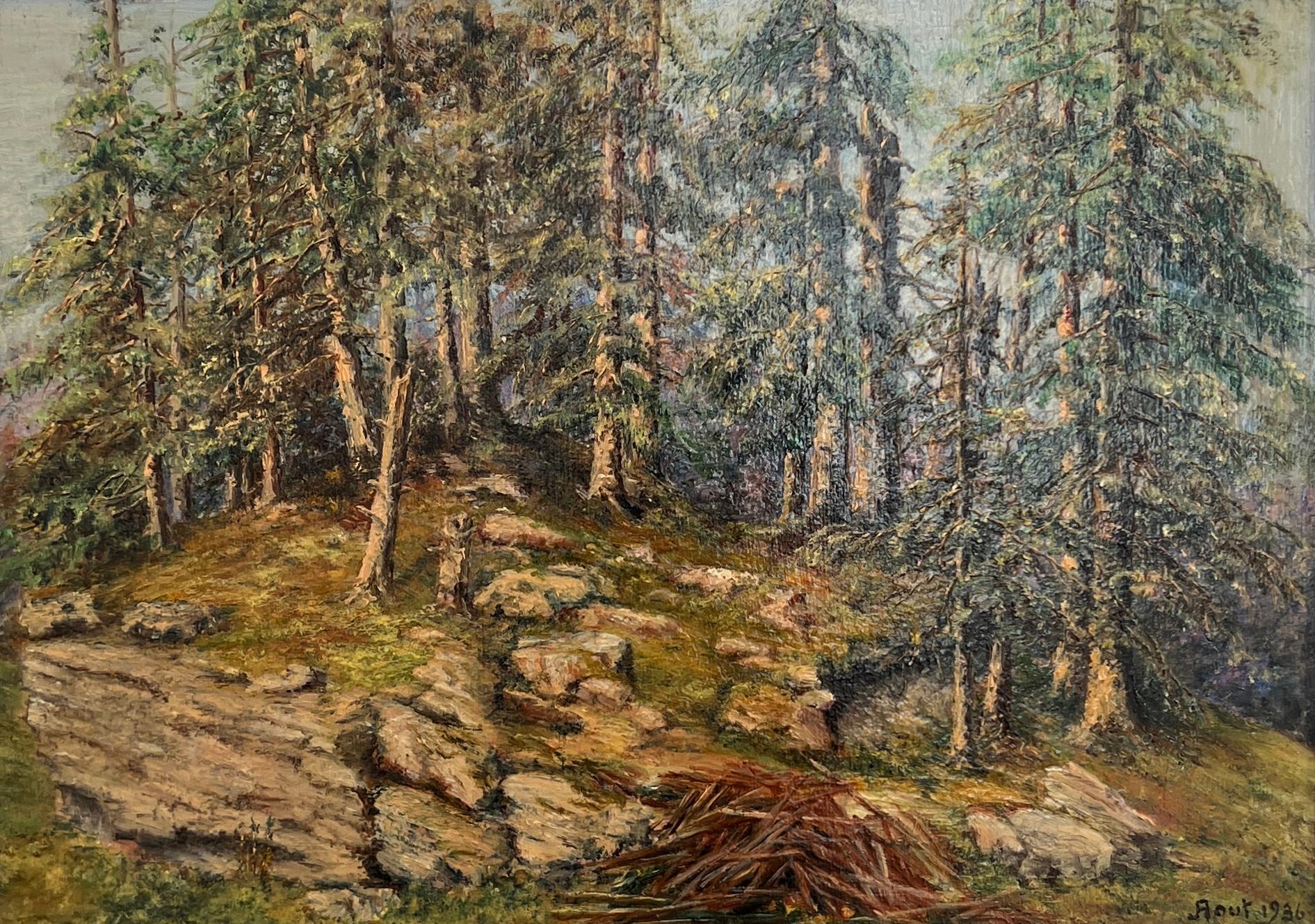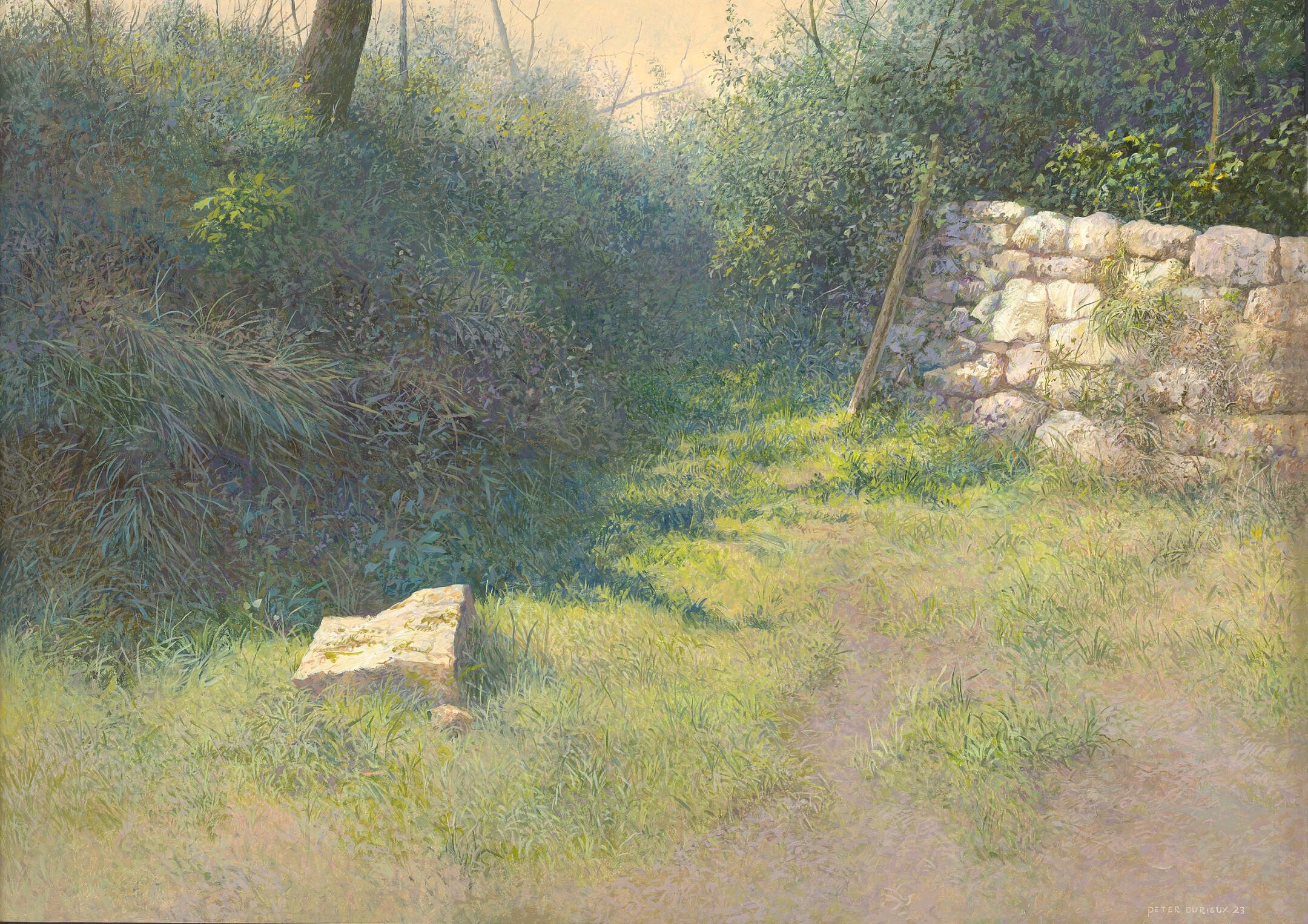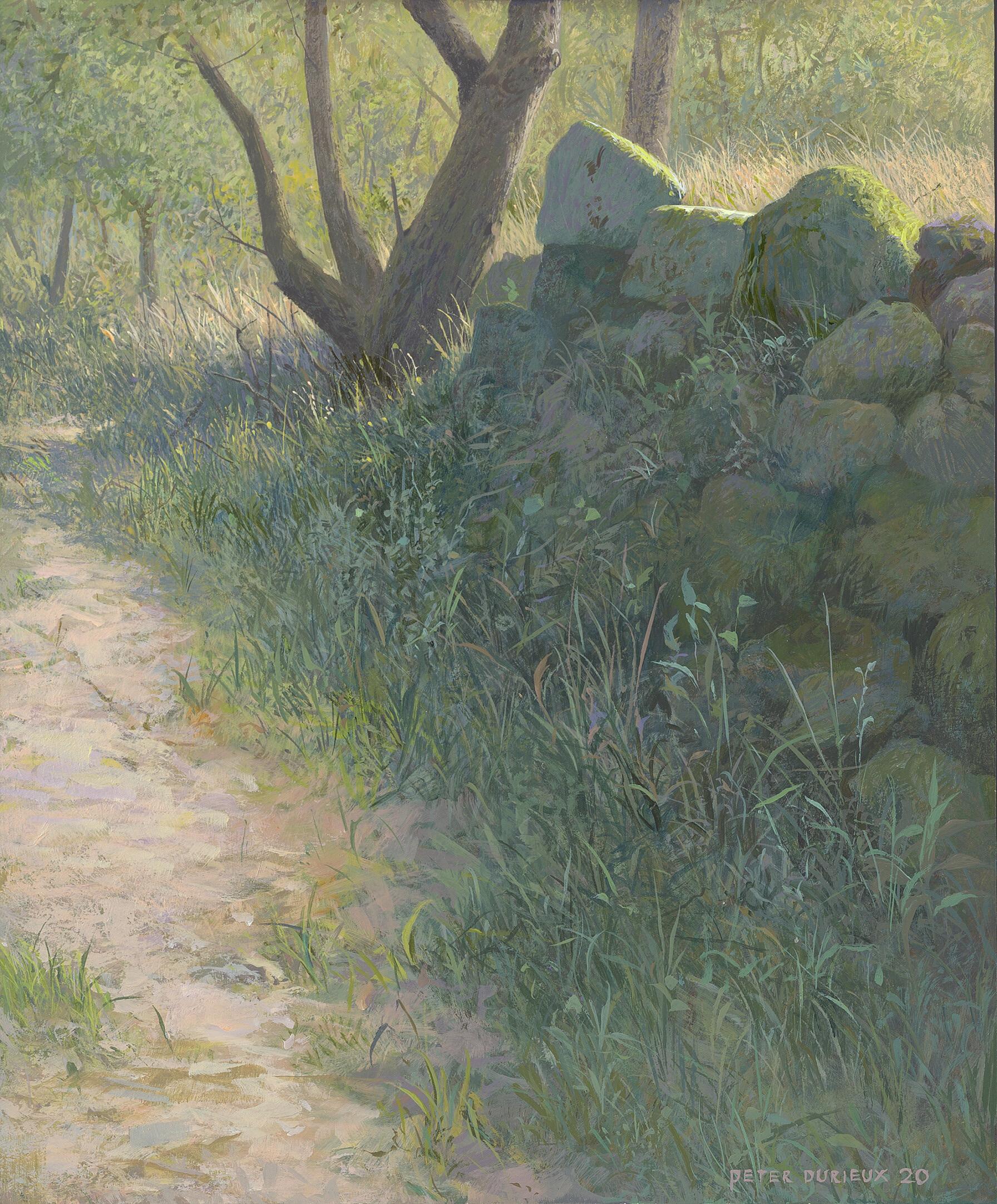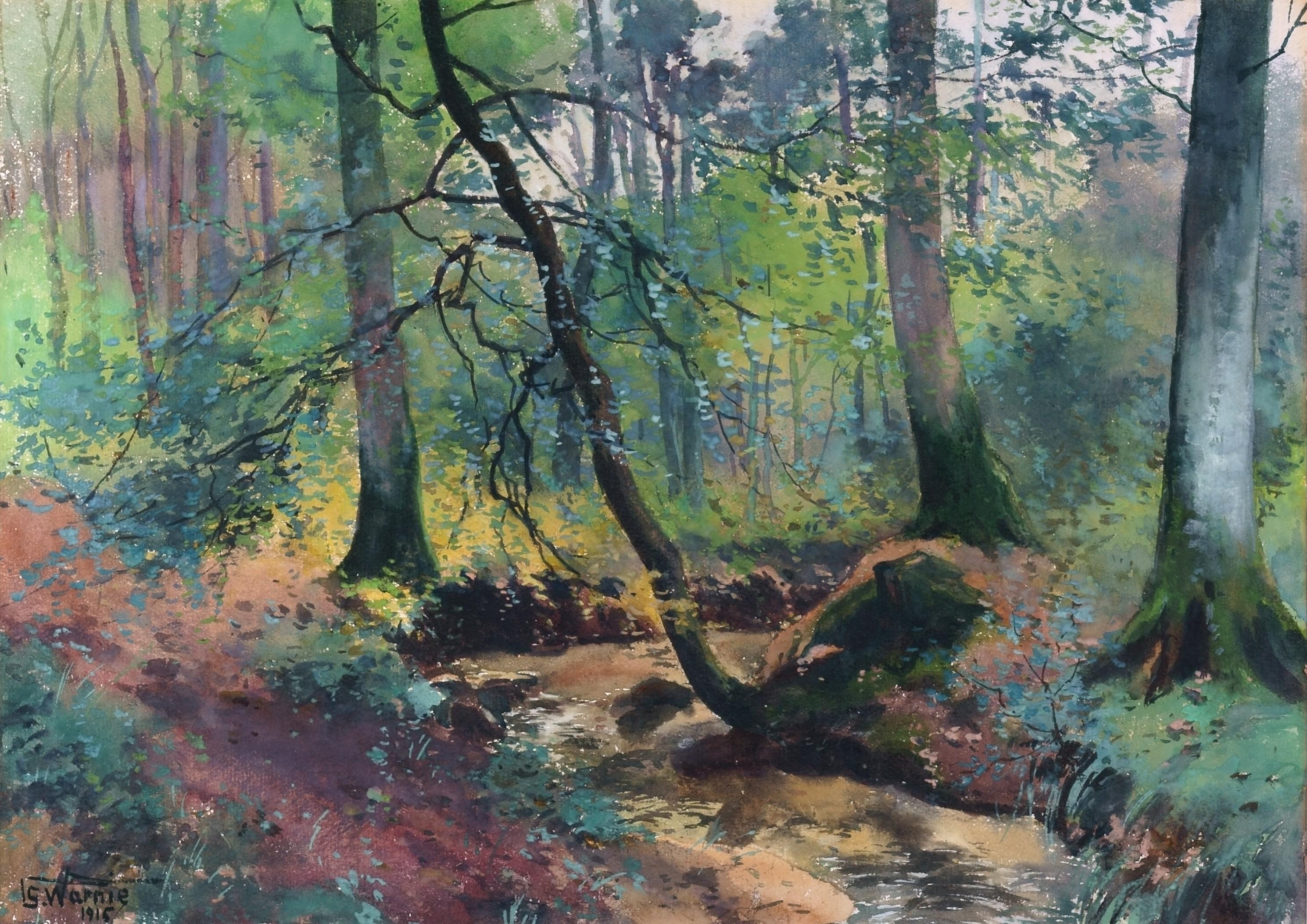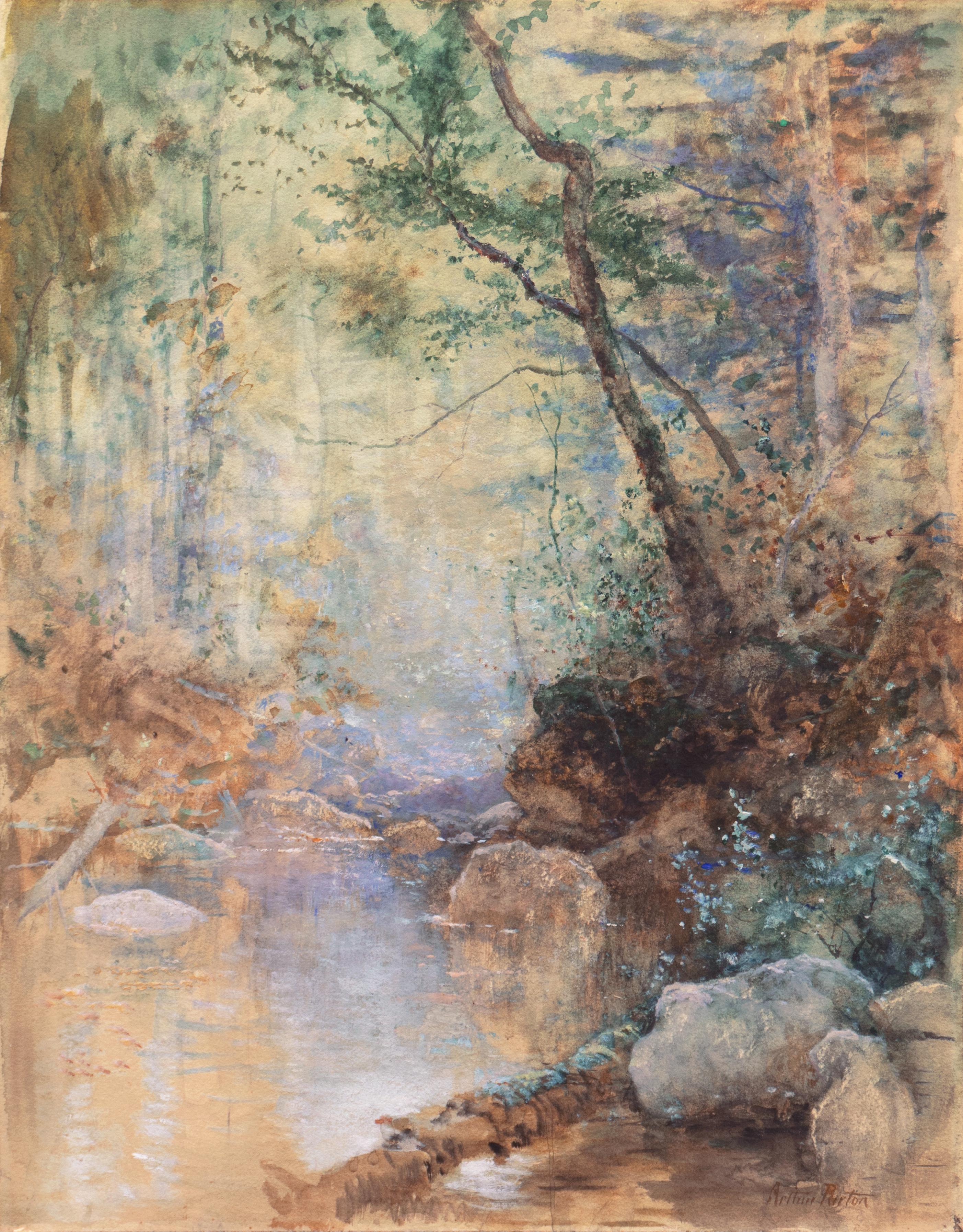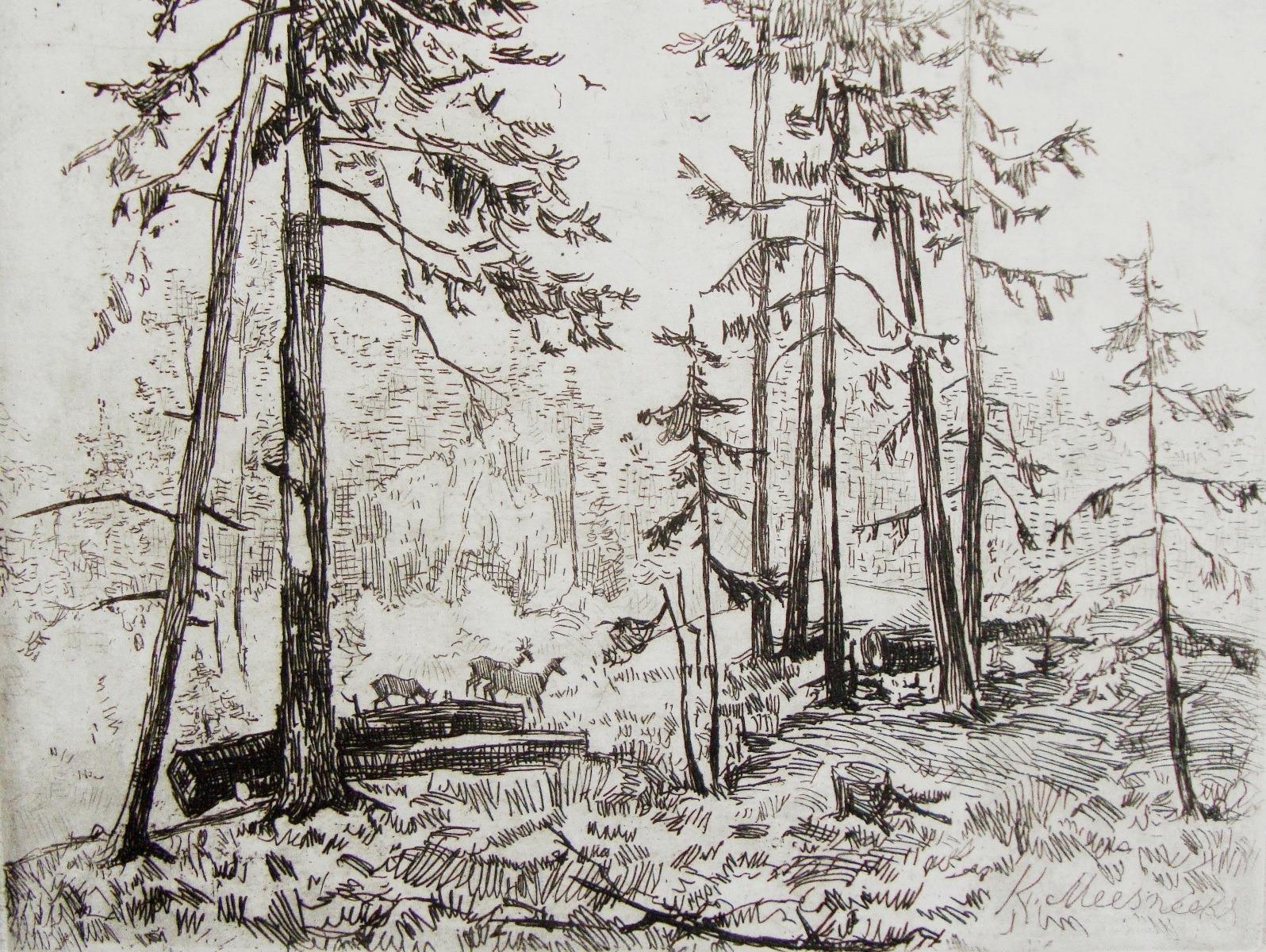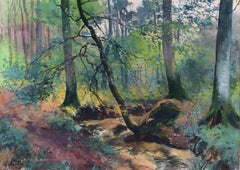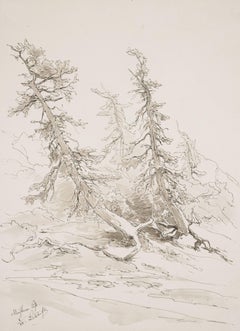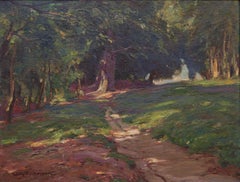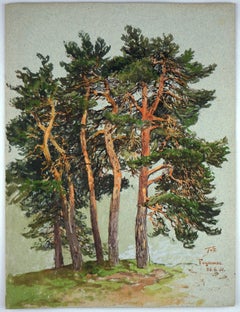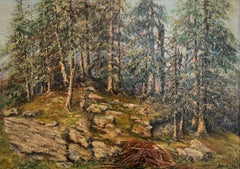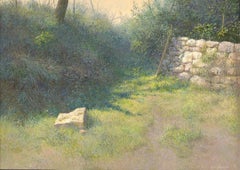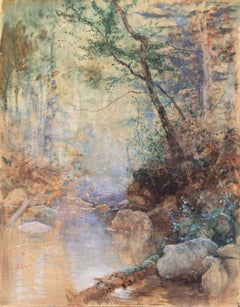Items Similar to Shady hollow way - Into the heart of the forest -
Want more images or videos?
Request additional images or videos from the seller
1 of 8
Hans DvoràkShady hollow way - Into the heart of the forest -1888
1888
$1,326.23
$1,657.7820% Off
£995.26
£1,244.0720% Off
€1,120
€1,40020% Off
CA$1,857.68
CA$2,322.1020% Off
A$2,038.52
A$2,548.1520% Off
CHF 1,055.46
CHF 1,319.3320% Off
MX$24,402.78
MX$30,503.4720% Off
NOK 13,241.86
NOK 16,552.3320% Off
SEK 12,458.04
SEK 15,572.5520% Off
DKK 8,533.21
DKK 10,666.5120% Off
About the Item
Hans Dvořák (19th century). Shady hollow way in a sunny forest. Watercolour and pen-and-ink drawing, 58.5 x 43 cm (visible size), 70 x 55.5 cm (frame), signed and dated "Hans Dvořák [18]88" at lower left.
Framed under glass.
- Into the heart of the forest -
About the artwork
This large watercolour depicts a sparse forest landscape in the glaring light of the midday sun. Immediately in front of the viewer, a stream crosses the path, its refreshing coolness accentuated by the surrounding shadows. Beyond the stream, the terrain is brightly lit. Here, the water-logged plants are in full bloom, while the pile of wood, faded by the strong sun, has taken on the grey colour of the rocky ground, contrasting with the green of the foliage. Between the green carpet of leaves on the left and the pile of wood on the right is the mouth of a slightly ascending, tunnel-like vaulted path, which leads out again into the bright summer sun, so that the light blue background of the sky illuminates the dark forest passage from behind.
The sequence of light and shadow, from the shadow of the immediate foreground into the light, from the light back into the shadow and from there back into the foreseeable light, gives the picture a strong narrative dimension, supported by the timeless atmosphere of the noon hour. And yet, following the panta rhei of the stream, time passes. The leaves of the delicate tree standing next to the pile of dead wood have already taken on a slight autumnal hue. The picture's oscillation between narrative and atmosphere is also to be found at the level of artistic creation: the representational quality, clearly outlined with the pencil, fades into a diffuse atmosphere through the character of the watercolour. The picture is both luminous and mysterious.
With this work, Hans Dvorak has created a close-up landscape inspired by plein air painting, whose intense appeal is rooted in the 'naturalistic allegory' established by Romantic landscape painting. In this way, Dvorak is at the height of traditional landscape painting, which reached its peak in the late 19th century and was associated with the unfathomable creation.
GERMAN VERSION
Hans Dvořák (19. Jh.). Schattiger Hohlweg in einem sonnigen Wald. Aquarell und Feder, 58,5 x 43 cm (Sichtmaß), 70 x 55,5 cm (Rahmen), links unten signiert und datiert „Hans Dvořák [18]88“.
Unter Glas gerahmt.
- Ins Innerste des Waldes -
zum Werk
Das großformatige Aquarell zeigt eine lichte Waldlandschaft im gleißenden Licht der Mittagssonne. Unmittelbar vor dem Betrachter quert ein Bach den Weg, dessen erfrischende Kühle durch die umgebenden Schatten noch hervorgehoben wird. Jenseits des Bachlaufs ist das Gelände hell beschienen. Hier präsentieren sich die bodennahen, vom Wasser gespeisten Gewächse in ihrer ganzen vegetativen Kraft, während das aufgeschichtete, von der starken Sonne ausgeblichene Holz die gräuliche, mit dem Grün des Blattwerks kontrastierende Farbe des felsigen Bodens angenommen hat. Zwischen dem grünen Blätterteppich links und dem Holzstapel rechts liegt die Mündung eines leicht ansteigenden, tunnelartig überwölbten Weges, der abermals in die lichte Sommersonne hinausführt, so dass der hellblaue Fond des Himmels die dunkle Waldpassage von hinten durchleuchtet.
Die vom Schatten des unmittelbaren Bildvordergrundes ins Lichte, vom Lichten erneut ins Verschattete und von dort wieder ins erahnbare Licht führende Licht-Schatten-Abfolge verleiht dem Bild eine stark erzählerische Dimension, die von der zeitlosen Atmosphäre der mittäglichen Stunde getragen wird. Und doch verfließt - dem panta rhei des Baches folgend - die Zeit. Die Blätter des neben dem Stapel abgestorbenen Holzes stehenden zarten Baumes haben bereits eine leichte herbstliche Einfärbung angenommen. Das Changieren des Bildes zwischen Erzählung und Atmosphäre findet sich auch auf der Ebene der künstlerischen Formierung: Die mit der Feder klar konturierte Gegenständlichkeit verschwebt durch den Charakter des Aquarelles ins Diffus-Atmosphärische. Das Bild ist durchlichtet und geheimnisvoll zugleich.
Mit diesem Werk hat Hans Dvorak ein an der plein air Malerei inspiriertes nahsichtiges Landschaftbild geschaffen, dessen intensive Anziehungskraft in der ‚naturalistischen Allegorie‘ wurzelt, wie sie von der Landschaftsmalerei der Romantik begründet worden ist. Damit bewegt sich Dvorak ganz auf der Höhe der im späten 19. Jahrhundert zur letzten Blüte gebrachten, auf die unergründliche Schöpfung bezogenen traditionellen Landschaftsmalerei.
- Creator:Hans Dvoràk (activ from 1880 - 1915, Austrian)
- Creation Year:1888
- Dimensions:Height: 23.23 in (59 cm)Width: 16.93 in (43 cm)
- Medium:
- Movement & Style:
- Period:
- Condition:
- Gallery Location:Berlin, DE
- Reference Number:1stDibs: LU2438212325792
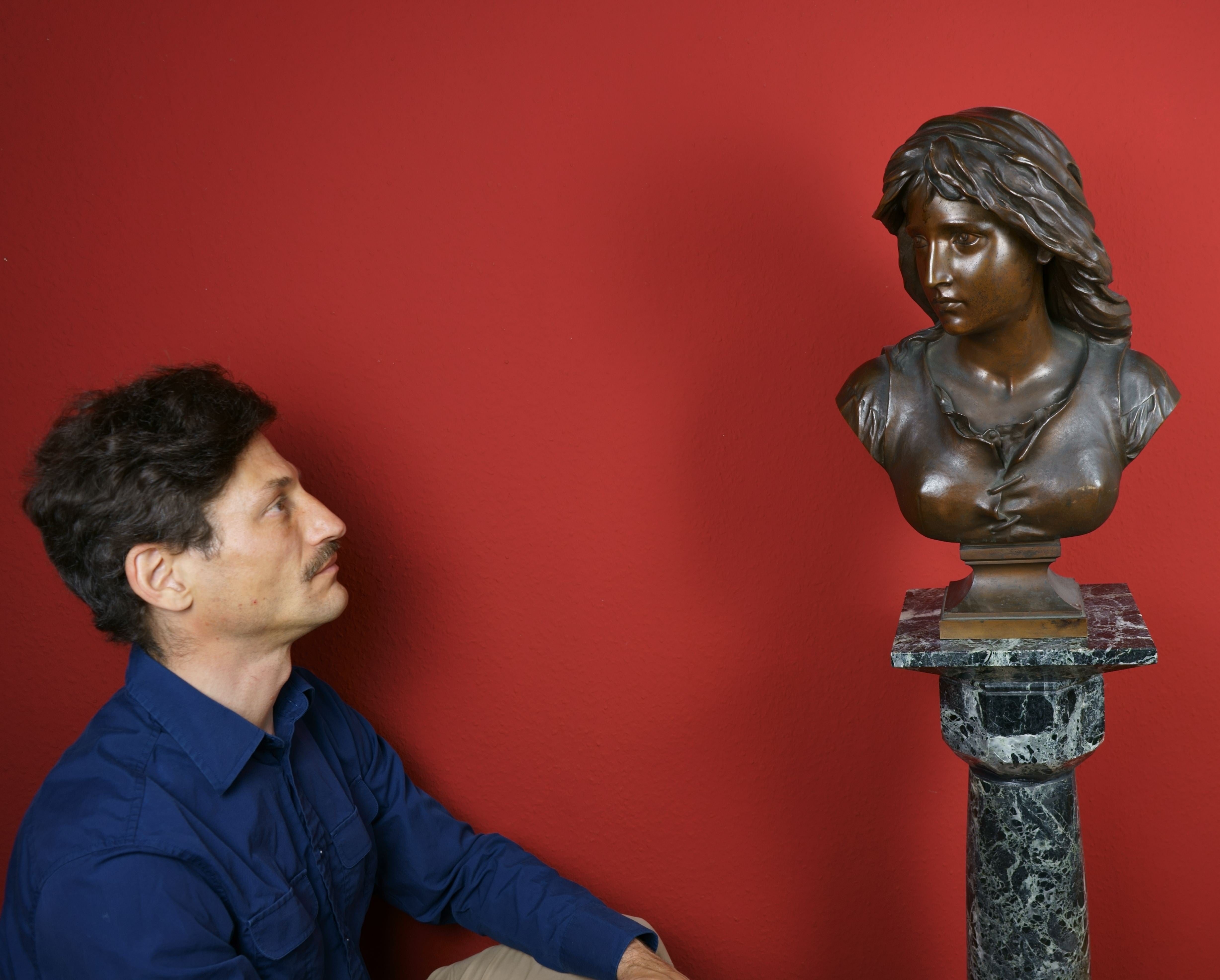
About the Seller
5.0
Vetted Professional Seller
Every seller passes strict standards for authenticity and reliability
Established in 2014
1stDibs seller since 2023
21 sales on 1stDibs
- ShippingRetrieving quote...Shipping from: Berlin, Germany
- Return Policy
Authenticity Guarantee
In the unlikely event there’s an issue with an item’s authenticity, contact us within 1 year for a full refund. DetailsMoney-Back Guarantee
If your item is not as described, is damaged in transit, or does not arrive, contact us within 7 days for a full refund. Details24-Hour Cancellation
You have a 24-hour grace period in which to reconsider your purchase, with no questions asked.Vetted Professional Sellers
Our world-class sellers must adhere to strict standards for service and quality, maintaining the integrity of our listings.Price-Match Guarantee
If you find that a seller listed the same item for a lower price elsewhere, we’ll match it.Trusted Global Delivery
Our best-in-class carrier network provides specialized shipping options worldwide, including custom delivery.More From This Seller
View AllSummer Forest Landscape, 1915 / - The Forest Walk -
Located in Berlin, DE
Stanislas Warnie (1879-1958), Summer Forest Landscape, 1915. Watercolor, 31.5 cm x 45 cm (passepartout), 50.5 cm x 63.5 cm (frame), signed "S. Warnie" at lower left and dated "1915"....
Category
1910s Art Nouveau Landscape Drawings and Watercolors
Materials
Watercolor
$615 Sale Price
20% Off
Woodland / - The Inner Drama of the Landscape -
Located in Berlin, DE
Eduard Peithner von Lichtenfels (1833 Vienna - 1913 Berlin), Woodland, 1884. Watercolor and pen and ink on drawing paper, 30.4 cm x 22.5 cm, signed, dated and inscribed by the artist...
Category
1880s Landscape Drawings and Watercolors
Materials
Paper
Forest landscape bathed in sunlight / - The Monumentality of the Forest -
Located in Berlin, DE
Wilhelm Feldmann (1859 Lüneburg - 1932 Lübeck), Sunny forest landscape, c. 1900. Oil on canvas, marouflaged on wood, 37 cm x 48 cm (inside dimensions), 42.5 cm x 53.5 cm (frame), sig...
Category
Early 1900s Impressionist Landscape Paintings
Materials
Oil
Norwegian Pine Grove - The inner glow of the trees -
Located in Berlin, DE
Themistokles von Eckenbrecher (1842 Athens - 1921 Goslar), Norwegian pine grove, 1901. Watercolor on blue-green paper, 30 x 22 cm. Signed, dated and inscribed in his own hand "TvE. Fagermes [i.e. Fagermes]. 26.6.[19]01."
- Slight crease throughout at left margin, otherwise in good condition.
About the artwork
Themistokles von Eckenbrecher often traveled to Norway to study the nature that fascinated him there. On June 26, 1901, near the southern Norwegian town of Fagernes, in the summer evening sun, he saw a small pine grove, which he immediately captured in a watercolor. He exposed the trees growing on a small hill in front of the background, so that the pines completely define the picture and combine to form a tense motif. The tension comes from the contrast of form and color. The trunks, growing upward, form a vertical structure that is horizontally penetrated by the spreading branches and the pine needles, which are rendered as a plane. This structural tension is further intensified by the color contrast between the brown-reddish iridescent trunks and branches and the green-toned needlework.
Themistokles von Eckenbrecher, however, does not use the observed natural scene as an inspiring model for a dance of color and form that detaches itself from the motif and thus treads the path of abstracting modernism. Its inner vitality is to be brought to light and made aesthetically accessible through the work of art.
It is precisely in order to depict the inner vitality of nature that von Eckenbrecher chooses the technique of watercolor, in which the individual details, such as the needles, are not meticulously worked out, but rather a flowing movement is created that unites the contrasts. The trees seem to have formed the twisted trunks out of their own inner strength as they grew, creatingthose tense lineations that the artist has put into the picture. The inner strength continues in the branches and twigs, culminating in the upward growth of the needles. At the same time, the trunks, illuminated by the setting sun, seem to glow from within, adding an almost dramatic dimension to the growing movement.
Through the artwork, nature itself is revealed as art. In order to make nature visible as art in the work, von Eckenbrecher exposes the group of trees so that they are bounded from the outside by an all-encompassing contour line and merge into an areal unity that enters into a figure-ground relationship with the blue-greenish watercolor paper. The figure-ground relationship emphasizes the ornamental quality of the natural work of art, which further enforces the artwork character of the group of trees.
With the presentation of Themistokles von Eckenbrecher's artistic idea and its realization, it has become clear that the present watercolor is not a study of nature in the sense of a visual note by the artist, which might then be integrated into a larger work context, but a completely independent work of art. This is why von Eckenbrecher signed the watercolor. In addition, it is marked with a place and a date, which confirms that this work of nature presented itself to him in exactly this way at this place at this time. At the same time, the date and place make it clear that the natural work of art has been transferred into the sphere of art and thus removed from the time of the place of nature.
About the artist
Themistocles' parents instilled a life of travel in their son, who is said to have spoken eleven languages. His father, who was interested in ancient and oriental culture, was a doctor and had married Francesca Magdalena Danelon, an Italian, daughter of the British consul in Trieste. During a stay in Athens - Gustav von Eckenbrecher was a friend of Heinrich von Schliemann and is said to have given him crucial clues as to the location of Troy - Themistokles saw the light of day in 1842.
After an interlude in Berlin, where Themistokles was educated at the English-American School, the journey began again. From 1850 to 1857 the family lived in Constantinople, after which the father opened a practice in Potsdam, where Themistokles, who wanted to become a painter, was taught by the court painter Carl Gustav Wegener.
In 1861 the von Eckenbrechers left Potsdam and settled in Düsseldorf. There Themistokles received two years of private tuition from Oswald Aschenbach, who greatly admired the talented young artist. After his artistic training, he undertook extensive travels, often accompanied by Prince Peter zu Sayn-Wittgenstein, which took him to northern and eastern Europe, but above all to the Middle East and even to South America. The paintings that resulted from these journeys established his artistic reputation and led to his participation in large panoramas such as the 118 x 15 metre Entry of the Mecca Caravan into Cairo, painted for the City of Hamburg in 1882.
1882 was also the start of a total of 21 study trips to Scandinavia, most of them to Norway, and the unique Norwegian landscape with its rugged fjords became a central motif in his work. Along with Anders Askevold and Adelsteen Normann...
Category
Early 1900s Naturalistic Landscape Drawings and Watercolors
Materials
Watercolor
$1,136 Sale Price
20% Off
Landscape verso Forest interior / - Landscape as a space of imagination -
Located in Berlin, DE
Herbert Seidel (1906 Berlin - 1974 Rüdersdorf), Landscape verso Forest interior, around 1950. India ink on grained, bleached paper, 40.5 x 58 cm, signed “Herbert Seidel” in pencil on...
Category
1950s Abstract Landscape Drawings and Watercolors
Materials
Paper
S. Anton Patenkirchen / - The Home of the Landscape -
Located in Berlin, DE
Hans Thoma (1839 Bernau - 1924 Karlsruhe), S. Anton Patenkirchen, 1895. Algraph on strong wove paper, published by Breitkopf und Härtel in Leipzig as ‘Zeitgenössisches Kunstblatt Nr....
Category
1890s Realist Figurative Prints
Materials
Paper
You May Also Like
Path of the woods
Located in Genève, GE
Work on cardboard
Golden wooden frame
32 x 40.5 x 3 cm
This work of art depicts a forest scene of remarkable and serene beauty. The painting captures the majesty of a coniferous for...
Category
1930s Landscape Paintings
Materials
Oil
Hidden Path - 21st Century Contemporary Landscape Painting of a Forest
By Peter Durieux
Located in Nuenen, Noord Brabant
Peter Durieux
Hidden path
30 x 42 cm (Framed, included in price 43 x 56 cm)
The work of Durieux is characterized by serene French landscapes. In recent years, he has also created wo...
Category
2010s Contemporary Landscape Paintings
Materials
Acrylic, Wood Panel
Pad - 21st century Contemporary landscape Painting of a forest
By Peter Durieux
Located in Nuenen, Noord Brabant
Peter Durieux
Pad
19,7 x 16,3 cm (Framed, included in price 30 x 26,5 cm)
The work of Durieux is characterized by serene French landscapes. In recent years, he has also created work...
Category
2010s Contemporary Landscape Paintings
Materials
Acrylic, Wood Panel
'Woodland Stream', Paris, New York, Hudson River School, Luminism, AIC, PAFA
By Arthur Parton
Located in Santa Cruz, CA
Signed lower right, 'Arthur Parton' (American, 1842-1914) and painted circa 1885.
This notable Hudson River School painter first studied under William Trost Richards, from whom he g...
Category
1880s Hudson River School Landscape Drawings and Watercolors
Materials
Paper, Watercolor, Gouache, Postcard
Forest
Located in Riga, LV
Karlis Miesnieks (1887.31.I – 1977.25.X)
Studied in the studio of J. Madernieks (1910), in Petersburg society of Imperial art promotion school (1911) and he graduated class of theat...
Category
1940s Realist Figurative Drawings and Watercolors
Materials
Paper, Etching
Forest - Watercolor by French Master - Mid 20th Century
Located in Roma, IT
Trees of Forest is an original painting in watercolor by an anonymous French Master of the XX century. The state of preservation is good and aged with si...
Category
Mid-20th Century Figurative Drawings and Watercolors
Materials
Watercolor
More Ways To Browse
The Antique Hearts
Realist Forest Paintings
Paintings Signed Taylor
Stanley Woodward
Albert Rutherston
Avigdor Bezalel
Beer Watercolor
Black Country Watercolours
Cannes Watercolour
Drawing Of The Taj Mahal
Hans Berger
Neel Reid
Vermont Watercolors
Charles March Gere
John Aldridge
Paul Marny
British Landscape 1930s
Cargo Ship Art
